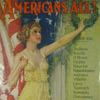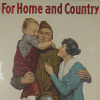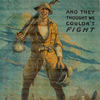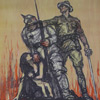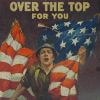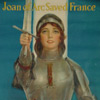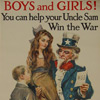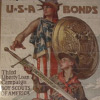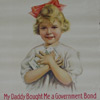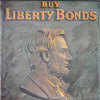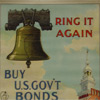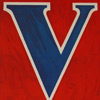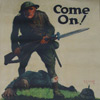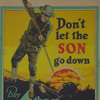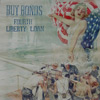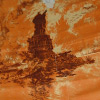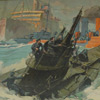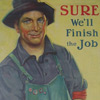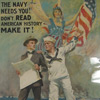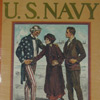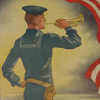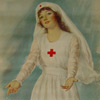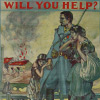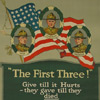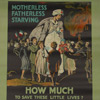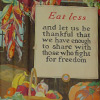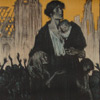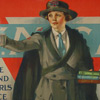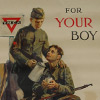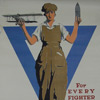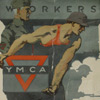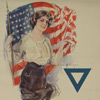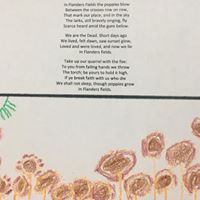Educational Programs
Along with guided educational tours, the MacArthur Museum of Arkansas Military History also provides fun, yet educational programs. Programs offered provide students with an experience they cannot receive in the classroom, yet are designed to better expand their learning and understanding of military, as well as local, State and National topics. All programs listed below are offered at no charge. Please feel free to ask for topics outside of those listed.
To schedule a program, please call (501-376-4602) or email macarthur@littlerock.gov
All educational programs are free!
First Call: American Posters of World War I
“First Call: American Posters of World War I” is an educational program appropriate for 4th - 12th grade students that takes a look at World War I propaganda posters. This program is offered on-site at the Museum and as part of our outreach programming. “First Call” includes lesson plans, PowerPoint presentations, worksheets, and hands-on experience with primary sources.
“First Call: American Posters of World War I” is funded by Mrs. Helen T. Leigh in memory of her husband Lt. Col. Gilbert Leigh, U.S. Air Force. Posters are from the MacArthur Museum of Arkansas Military History Collection. Learn more about the Helen T. Leigh Museum Field Trip Grant.
Images of War Posters for Analysis by Students
Fundraising Posters
Recruiting Posters
Red Cross Posters
Conservation Posters
United War Work Campaign Posters
The enormous output of posters in the United States during and just after the first World War belies this country’s late entry into that conflict. Spurred by the example of various European combatants, the creation and production of appropriate “pictorial publicity” quickly achieved a high level of artistic involvement and industrial application. Thousands of designs were created and most of them were printed in large numbers. As a result few of these posters are scarce even today, and only a handful qualify as “rare.” A large number of artists were involved in the creation of posters. Some of them, such as Howard Chandler Christy and James Montgomery Flagg, came to the work with their reputations already secured through their commercial work in books, magazines, and advertising. Many of the artists, whether obscure or famous, contributed their work “gratis” to the war effort.
The posters helped not only with the obvious aim of recruiting members for the armed forces, but with the parallel home-front efforts embodied in various conservation efforts, such as the United War Work Campaign, the Red Cross and perhaps most notably in the rapid subscription of the Liberty and Victory Loans. Posters commonly urged wartime thrift and were vocal in seeking funds from the general public via subscription to the war bond efforts.
Each of the four Liberty Loan Campaigns (two in 1917, two in 1918) and the Victory Loan Campaign of 1919, brought an outpouring of poster art on both the local and national levels. The Liberty and Victory Loan drives raised approximately 30 billion dollars and did much for the proliferation of the poster as an important means of war effort communication. Interestingly, despite the U.S. late entry into the war, this country produced more propaganda posters than any other single nation.
The program is appropriate for 4th - 12th grade students.
Program Guide & Frameworks: First Call Lesson Plans
Summary of First Call Program
Food for Thought
Napoleon is credited with saying “An army marches on its stomach.” In other words, it’s through diet and nutrition that an army – that soldiers – are able to have the strength and energy to achieve the physical demands placed upon them. If soldiers are too weak and malnourished to complete their objective, it could lead to disaster.
"Food for Thought" is an educational program during which students will explore the different kinds of foodstuff the common U.S. soldier has had to live on from the time of the Civil War up to the present. By using both original and reproduction mess gear, along with real food, students will be presented with a timeline of a soldier’s diet.
Program provides an introduction to the history of army rations, and what all soldiers have fundamentally been given by the Government to eat while living in the field. Through several hands-on activities utilizing primary sources, students will learn about the importance of hydration, healthy food options, calories, carbohydrates and the need for a healthy diet in order to maintain physical health and fitness. Additionally, students will learn about homefront rationing and food conservation.
The program is appropriate for K -12th grade students.
Program Guide & Frameworks:
Summary for Food for Thought Program
Food for Thought Frameworks
Remember Me
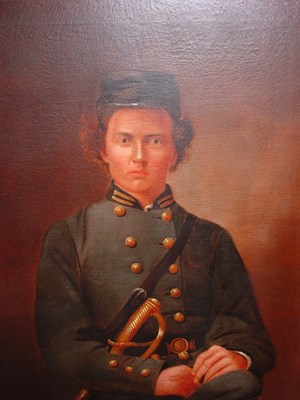 In a war that created such historical figures as Robert E. Lee, U.S. Grant, “Stonewall” Jackson, and others, "Remember Me" is an educational program that focuses on specific Arkansans during the Civil War. Each of the featured Arkansans has a unique and different story, with some better known than others.
In a war that created such historical figures as Robert E. Lee, U.S. Grant, “Stonewall” Jackson, and others, "Remember Me" is an educational program that focuses on specific Arkansans during the Civil War. Each of the featured Arkansans has a unique and different story, with some better known than others.
“Remember Me” looks at those stories more closely, examining how and why 150 years later our society still feels the need to memorialize these individuals. But what about those Arkansans whose stories are not told? Whose likeness is not made into a bronze statue or portrait hanging in a museum? Are their stories, trials and tribulations any less than those few our society has determined needs to be remembered? And how does this transcend into our culture and society today?
During this program, students will reflect upon who they memorialize and why, with the intention of looking deeper at what makes a “hero” or a person worth remembering.
This program is appropriate for 4th - 12th grade students.
Program Guide & Frameworks:
Summary of the Remember Me Program
Program Lesson Plans
The Art of War
Explaining the emotions, turmoil, and aspects of war from not only the soldier's point of view, but also society's viewpoint to students can be a challenging task. Textbooks tend to generalize the impact of war on a nation's homefront, a soldier's family, a destroyed community, and the enemy. However, artwork can often portray the emotional burdens of war experienced by those who are actively participating.
"The Art of War" educational program utilizes diverse historical art mediums, such as photography, paintings, cartoons, and films, to creatively explore with students the humanity in war. Through discussion and analysis of wartime photography, art as a memorial, and art made by soldiers and veterans, "The Art of War" program offers students an alternative to secondary source accounts of war and conflict.
To view the "Wartime Photography: WWII & Vietnam War" lesson plan, click here.
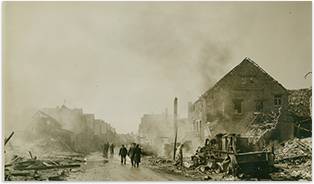





 Trash & Recycling
Trash & Recycling
 Online Payments
Online Payments
 City Documents
City Documents
 Parks
Parks
 Traffic Court
Traffic Court
 CITY PARKS
CITY PARKS
 Outdoor Recreation
Outdoor Recreation
 Volunteer
Volunteer
 Home
Home TRANSLATE
TRANSLATE
